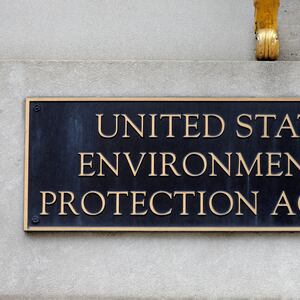The global market for cosmetics—makeup, skincare, perfumes, deodorants, hair products, shampoos, conditioners and more—continues to boom, growing 16.2 percent in 2022 from 2021, according to a report by Statista. But as we buy more of these products, we risk increasing our exposure to so-called “forever chemicals”—Per- and polyfluoroalkyl substances (PFAS)—that have been linked to a plethora of different diseases, including cancer, hormonal disruptions, weakened immune systems, and reproductive issues. A 2021 study led by researchers at Notre Dame ran tests on 231 cosmetic products, and found PFAS in nearly half of them.
The presence of dangerous chemicals in consumer products isn’t exactly news, but “forever chemicals” live up to their nickname. “PFAS are called ‘forever chemicals’ for a reason,” Brian Moore, a dermatologist based in Cleveland and an adviser for supplements company Illuminate Labs, told The Daily Beast. “They take extremely long to naturally degrade, and for that reason can damage natural ecosystems and can even affect non-consumers exposed through environmental contamination.”
Studies have shown that forever chemicals can linger in human blood for decades, and researchers at Stockholm University found that, in rainwater from around the globe, levels of one particular PFAS “greatly exceed” the advisory levels for drinking water in the U.S.. The implications of this finding are unsettling, suggesting that the water in our ecosystem is already contaminated with PFAS, in our soil, crops, livestock, wildlife and drinking water sources.
How has this been allowed to happen? The cosmetics and beauty industry is, notoriously, unregulated by the FDA, allowing companies free rein to create products at their discretion, hiding weird chemicals under the broad umbrella of “fragrance,” given that a brand’s fragrance involves its “trade secret.”
The FDA is aware of PFAS, why they are used in cosmetics, and the potential harm posed by these chemicals. Yet the agency only cites one study from 2018 on its website, noting that “studies are limited.” That’s in spite of the fact that a quick search on Google Scholar for “PFAS studies” since 2019 yields about 17,000 results.
Right now, the Federal Food, Drug and Cosmetic Act “does not require that cosmetic manufacturers or marketers test their products for safety,” and does allow ingredients “accepted by the FDA” to be exempt from public disclosure and stated as “and other ingredients” on cosmetics labeling and packaging.
Makeup products marketed as “waterproof,” “long-lasting,” or “wear-resistant” are especially likely to contain fluorine, a main component and indicator of any PFAS, as found by researchers in 2021. The same study found high levels of fluorine in 63 percent of foundations, 55 percent of lip products, and 82 percent of waterproof mascaras.
“PFAS can give skin a glossy sheen, so they’re intentionally added to cosmetics for that effect,” explained Moore. The popularity of durable makeup that can outlast the day’s sweat and the city’s grime means there is more demand for all-day wear, fueling the increase of PFAS in these products.
With the FDA’s promise to “monitor” PFAS in cosmetics, it seems, at this moment, that the onus is on the consumer to decide what might be safest for their skin.
But this Wild West of PFAS isn’t likely to last. Last week, the U.S. Environmental Protection Agency proposed new, first-of-their-kind regulations that would ban six of the most researched PFAS from drinking water. The European Chemical Agency, an agency of the European Union responsible for regulating chemicals, was first to publish a PFAS restriction proposal earlier this year. Both of these moves signal a growing pressure to protect consumers from PFAS.
And those moves aren’t much of a surprise as we learn more about PFAS. In September 2020, researchers published a study that found an alarmingly high association between PFAS and kidney cancer—including that patients with high levels of one particular chemical called PFOA in their blood were more than twice as likely to develop kidney cancer. Other studies have found significant correlations between elevated PFAS levels and testicular cancer, ovarian and endometrial cancer, prostate cancer, non-Hodgkin lymphoma, thyroid cancer, and childhood leukemia.
Naturally, the health effects mean people are starting to fight back in the most punitive ways they can: through litigation. “People’s litigation really follows the science,” Jayne Conroy, an attorney based in New York, told The Daily Beast. Conroy works with PFAS Law Firms, which represents firefighters who have been exposed to PFAS in heavily contaminated gear and heat-and-water-resistant firefighting chemicals and are now suffering from related health effects.
“What we’re finding through science is that it takes far less of these chemicals to produce disease, and it takes a much longer time, as we know, for many cancers to develop,” said Conroy. “So you’re seeing the litigation really react to the scientific information that’s coming out.”
Conroy drew a parallel with asbestos, noting that for a while, little was known about asbestos and the connected harms associated with it: mesothelioma or lung cancer.
“When the science becomes more definitive about the causation links, then you see the litigation begin to make some progress because you can prove the link between exposure and disease,” she said. “The same thing has happened with PFAS.”
There are some cosmetics companies that are hoping to avoid falling into any litigious pitfalls by preempting them outright, and looking for alternatives to PFAS in their own products. Axiology Beauty, based in Bend, Oregon, is a cosmetics company specially focused on making PFAS-free makeup. Founder Ericka Rodriguez began the company in her kitchen when she sought to create a clean, vegan, cruelty-free lipstick made from just ten ingredients. Axiology’s products now include multi-purpose eyeshadow, cheek rouge, and lip tint sticks.
Axiology’s line of makeup products are made from a pool of the same simple, non-toxic 10 ingredients—no more and no less. Those ingredients include organic coconut oil, avocado oil, castor seed oil, hydrogenated soybean oil, sunflower seed wax, grape seed oil, Sambucus nigra fruit extract, sunflower seed oil, tocopherol, and Azadirachta indica seed oil.
The company also attempts to make transparency a key draw for customers. When digging into ingredients on Axiology’s website, consumers can find hyperlinked descriptions of each individual ingredient, information on its derivation, and why the ingredient is being used in the product.
Another company doing some of the legwork in protecting consumers and companies alike is PreScouter who seeks to solve technical and commercial challenges by bringing together some of the world’s top experts and data sets.
“Companies need to know where PFAS may exist in their products, and where there are opportunities to replace PFAS while still allowing for the same functionality of the product,” Daniel Morales, a chemical engineer by trade and the current technical director at PreScouter, told The Daily Beast.
Morales explained that there are two main pathways forward in reducing the public health harms caused by PFAS: one focused on filtering out already existing PFAS from the environment, and one focused on replacing the PFAS in products with alternatives.
Last year in a public briefing, Morales and his team identified three PFAS alternatives to give consumers and companies a specific idea of how products could be made without them. These included organic and vegan cosmetics; strollers and car seats made without waterproof, PFAS-carrying materials (instead, made with cork and recyclable PET); and running industrial applications without using PFAS-contaminated parts.
“There are alternatives out there,” Morales said. “Companies just need to do their due diligence in finding them.”
Forecasting ahead, a future (more) free of PFAS in cosmetics looks bright. After all, Gen Z favors transparency, simple ingredients, and no-fuss beauty. But while PFAS alternatives will take time to introduce and become adopted by the beauty industry, consumers who are interested in protecting themselves can take one tried-and-true step already that may help them to avoid unwanted products: read the ingredient list.









